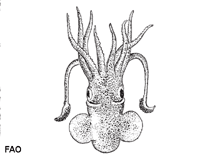Sepiola rondeletii Leach, 1817
Dwarf bobtail squid
Classification / Names Common names | Synonyms | CoL | ITIS | WoRMS
Cephalopoda | Sepiida | Sepiolidae | Sepiolinae
Environment: milieu / climate zone / depth range / distribution range Écologie
; profondeur 21 - 450 m (Ref. 275), usually ? - 35 m (Ref. 275). Subtropical; 81°N - 12°N, 85°W - 37°E
Distribution Pays | Zones FAO | Écosystèmes | Occurrences | Introductions
Eastern Atlantic, Mediterranean Sea and the Arctic: from North Sea to Senegal and throughout the Mediterranean. Subtropical to polar.
Length at first maturity / Taille / Poids / Âge
Maturity: Lm ? range ? - ? cm Max length : 2.5 cm ML mâle / non sexé; (Ref. 1695); 6 cm ML (female)
Common mantle length: 4 to 5 cm (Ref. 275). Common mantle length ranges between 4 and 5 cm (Ref. 3722). Minimum depth from Ref. 105700.
Life cycle and mating behavior Maturité | Reproduction | Frai | Œufs | Fécondité | Larves
Members of the class Cephalopoda are gonochoric. Male and female adults usually die shortly after spawning and brooding, respectively. Mating behavior: Males perform various displays to attract potential females for copulation. During copulation, male grasp the female and inserts the hectocotylus into the female's mantle cavity where fertilization usually occurs. Life cycle: Embryos hatch into planktonic stage and live for some time before they grow larger and take up a benthic existence as adults.
Référence principale
Références | Coordinateur | Collaborateurs
Wood, J.B. and C.L. Day. 1998. (Ref. 3722)
Statut dans la liste rouge de l'IUCN (Ref. 130435: Version 2024-1)
Données manquantes (DD) ; Date assessed: 30 March 2009
statut CITES (Ref. 108899)
Not Evaluated
CMS (Ref. 116361)
Not Evaluated
Menace pour l'homme
Utilisations par l'homme
Pêcheries: commercial
| FishSource |
Outils
Plus d'informations
Trophic Ecology
Ecology
Population dynamics
Croissance
Taille/Âge
Longueur-poids
Longueur-longueur
Fréquences de longueurs
Mass conversion
Recrutement
Abondance
Taille/Âge
Longueur-poids
Longueur-longueur
Fréquences de longueurs
Mass conversion
Recrutement
Abondance
Life cycle
Reproduction
Maturité
Fécondité
Frai
Œufs
Développement de l'œuf
Larves
Dynamique des populations larvaires
Maturité
Fécondité
Frai
Œufs
Développement de l'œuf
Larves
Dynamique des populations larvaires
Distribution
Human Related
Profil d'aquaculture
Stamps, Coins Misc.
Stamps, Coins Misc.
Outreach
Taxonomy
References
Sources Internet
BHL | BOLD Systems | CISTI | DiscoverLife | FAO(Publication : search) | Fishipedia | GenBank (genome, nucleotide) | GloBI | Gomexsi | Google Books | Google Scholar | Google | PubMed | Arbre de Vie | Wikipedia (Go, chercher) | Zoological Record
Estimates based on models
Catégorie de prix
(Ref. 80766):
Unknown.



